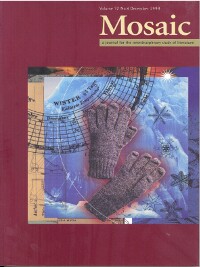Issue 32.4
Overview

General Issue
Published: December 1999
View the issue introduction or see the issue summary and contents below.
8 essays, totalling 156 pages
$15.00 CAD
This general issue of Mosaic is both the last of the twentieth century and the last of long-time Editor Evelyn J. Hinz (1979-99). It contains essays on musical rhetoric in The Portrait of a Lady, rap as poetry, and translation theories in transition. Concerned with psychological themes, the other essays in the issue focus on irony and deception in the works of Dmitri Shostakovich and paranoia in science fiction films.
Recognizing “False Notes”: Musical Rhetoric in The Portrait of a LadyLaura F. Hodges Drawing upon studies of the Medieval and Renaissance view of music as a mediator between the self and the cosmos, this essay explores the way that James uses and adapts such analogies to a social context in dramatizing Isabel’s evolution from innocence and dependence to experience and autonomy in The Portrait of a Lady. | |
Eugene Jolas and the Translation Policies of transitionCraig Monk The American expatriate magazine transition (1927-38) attempted to internationalize language and literature by including material from many countries. Focusing on the policies of its editor, Eugene Jolas, this essay explores why the magazine shifted away from publishing English translations toward publishing original foreign material and ultimately multi-lingual works and neologisms. | |
Irony, Deception, and Political Culture in the Works of Dmitri ShostakovichJennifer Gerstel The existence of irony in music is a topic that has recently attracted the attention of both musicologists and literary theorists. Focusing on the “double-voicedness” employed by Shostakovich under the Soviet regime, this essay explores the ways that the production and reception of musical irony are influenced by cultural and political context. | |
Schiller, Goebbels, and Paul de man: The Dangers of Comparative StudiesMichael T. Jones Schiller plays a prominent role in the works of Paul de Man, especially in de Mann’s lecture “Kant and Schiller,” where he concludes by likening Schiller’s concept of aesthetic humanism to the disastrous “education” performed by Joseph Goebbels. Focusing on the phenomenon of discipleship, this essay explores the politics of teaching comparative literature. | |
From Trauma to Paranoia: Nuclear Weapons, Science Fiction, and HistoryCyndy Hendershot Focusing on the ahistorical tendency in much science fiction, and placing it in the context of the political and scientific commentary on the Atomic Age, this essay explores the way that three science-fiction films of the 1950s resorted to paranoid defense-mechanisms in their attempt to deal with the trauma of nuclear destruction. | |
Angels by Way of and in the Laundry: Richard Wilbur’s Sacramental EkphrasisKevin J. Jessar Arguing that Richard Wilbur’s career-long preoccupation with locating a proper relation between the tangible world and the intangible leads him to put ekphrasis to new and fascinating uses, this essay examines how the struggle between image and text, visual and verbal representation is presented in six of his poems. | |
Mapping the Holocaust: The “Atlases” of Adrienne Rich and Gerhard RichterJoshua S. Jacobs In their representations of the Holocaust, Adrienne Rich and Gerhard Richter conjoin various artistic media to place its “unspeakable” history within an encyclopedic vision of contemporary culture. Focusing on the concept of “witnessing,” this essay explores how their respective strategies reflect different attitudes about the ethics of such depictions. | |
Understanding Rap as Rhetorical Folk-PoetryBrent Wood The popularity of Rap music has elicited a variety of critical responses, but very little focus on the poetry itself. This essay discusses Rap’s ties to earlier forms of African-American folk-poetry and analyzes the conventional structures of rhetoric, rhythm, and rhyme within which Rap artists operate. |